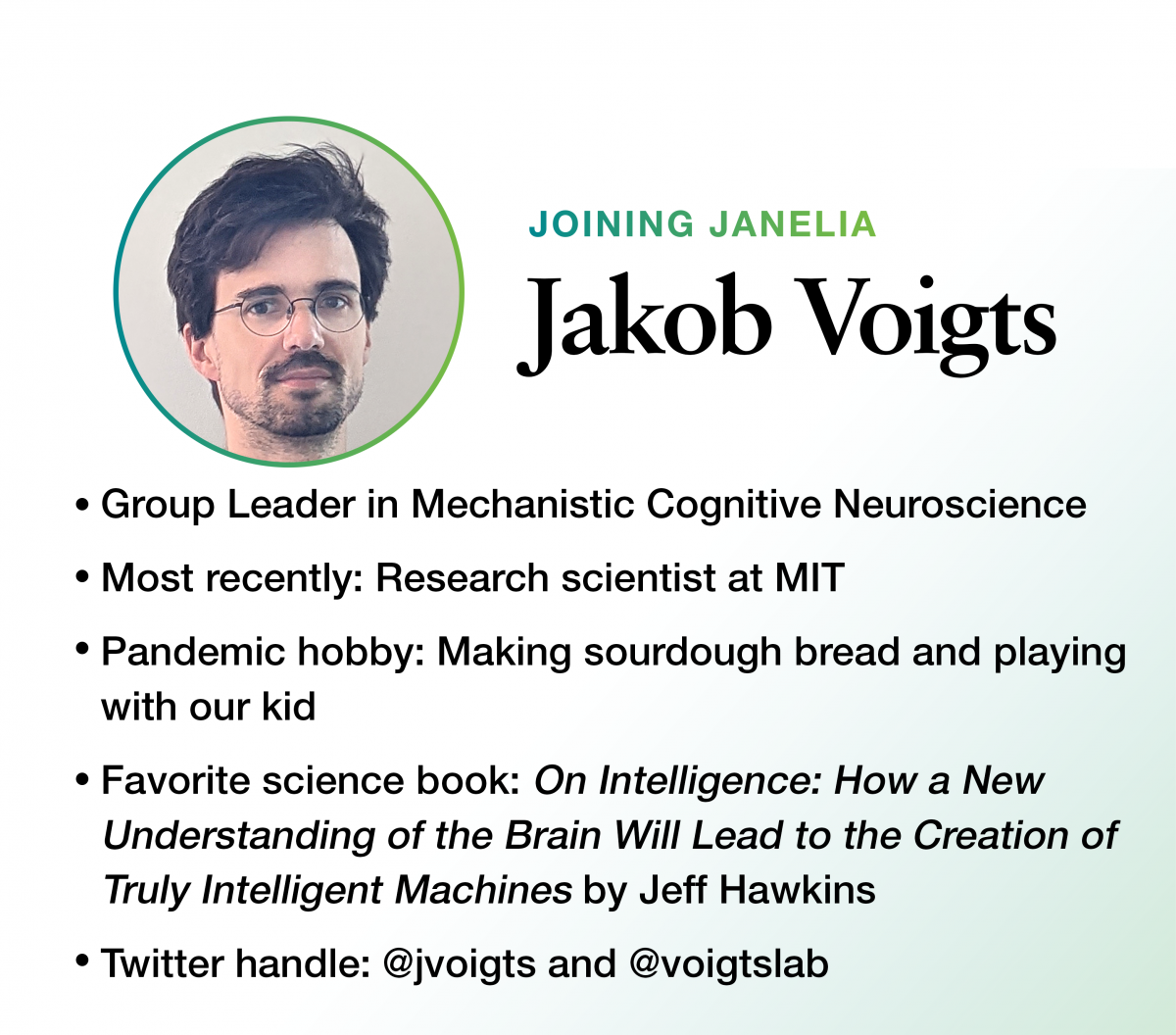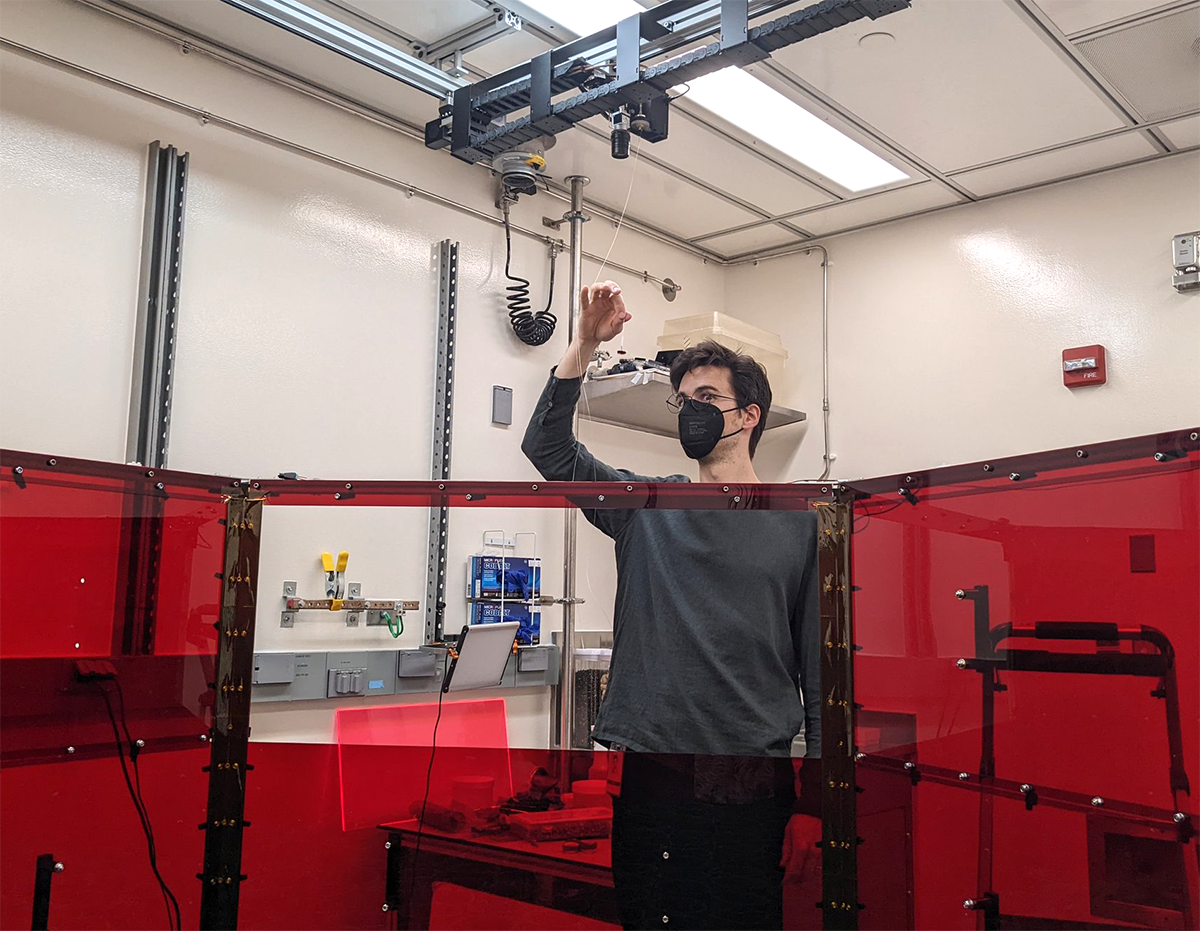Jakob Voigts started playing around with computers during high school in Germany, but the realization that a career in computer science meant programming for a living led him to study math instead. He had never even heard of neuroscience until he attended a summer school in the field during college and had his “mind blown” on discovering the computer inside the human head. From there, he helped develop software for whisker tracking in mice and he was hooked. We sat down with Voigts recently to hear about the research questions he plans to pursue at Janelia.

HHMI Janelia: Tell us about your research.
Jakob Voigts: I am ultimately interested in how we can do near-impossible things like abstract reasoning. Now, to study this in mice, this brings up the question of what kind of reasoning mice even do. I think some of the answers lie in embracing the clever things they do in their natural habitat: When you imagine a mouse out in a patch of grass or in the woods, there isn’t a lot of information that tells the mouse where it is because each patch of grass looks like every other patch of grass. If a mouse in that context is trying to get somewhere or get away from something, it needs to remember a lot of things and really think about where it is. One way to solve this problem is to piece together different bits of information to localize itself, like a rock you just saw, or which direction the sun is coming from, while keeping different possible interpretations of these bits of evidence in mind, much the same as we have to piece together words to understand a sentence.
So the idea is that when you allow mice to do interesting navigation behaviors, which they are naturally good at, they actually do pretty complex stuff. They exhibit a lot of flexibility in that, too, where they don’t just memorize, but can instead apply models of the world. They might know for instance that parts of the world change while others are more reliable landmarks, or memorize some pattern of rocks, and recognize it later under different circumstances.
Essentially, what we’re going to try to do here is to build on this existing behavior and make use of these relatively complex non-linear computations that mice can naturally do. That will allow us to study things that have always interested us in systems neuroscience: how the brain builds models of the world, and then uses these models to make sense of the world.
HJ: Why is it important to study this?
JV: A big idea in neuroscience is that the neocortex, the thing that makes mammals different from non-mammals, gives us the ability to flexibly apply models. If you encounter a situation that you have never encountered before, and you can’t rely on having memorized the right answer, you need to instead apply an understanding of the world to navigate the situation. We think about this process as using an ‘internal model of the world’ that allows you, for instance, to simulate the future and plan ahead for what might happen. One thing that goes with that is the ability to learn from an individual exposure to something, because you already have so much structured knowledge about what the world looks like that when you see a new thing for the first time, you already notice a lot of that. Like my 3-year-old could see a zebra for the first time, and then he’s never going to make a mistake about what’s a zebra and what a horse is. He already knows about horses and gazelles and lions, so it’s now easy to learn that a horse with stripes is a zebra.
Mice of course don’t have such categories, but we need to give them the opportunity to be clever and learn from single trials in different ways to study how the brain does that. This is one of these very hard problems in neuroscience, to get mice to be clever and have them in a situation where they can do something computationally complex in a single trial. Something that’s not a memorization, that’s not a long lookup table, and might only happen very occasionally, but is still interpretable so we can measure it and see how the brain applies such models, because, frankly, we have no idea.

HJ: What excites you about coming to Janelia to do this research?
JV: I think the main thing is the collaborative nature, the people, the technology, all giving us the ability to do hard things quickly. These projects are high risk, high reward in some sense, and being able to move quickly, not spend time writing grants, and have all the amazing support is absolutely important for that. Because it should be clear from the experiments I outlined, we’ll have to try a lot of stuff that will not work and we’ll need to iterate quickly. Janelia is the ideal place to do this.
I’ve already had so many conversations with people that give me confidence that we can really work on these tricky questions, because the community here is a great safety net, or a great wall to bounce ideas off. Everyone really engages deeply with questions across labs or groups. For many aspects of the research program we’re in somewhat new territory and I don’t feel qualified to solve some questions yet myself - I know how to make the experiments happen, and I think I have decent ideas how to think about the theory, but I’m not a proper theoretician. For this work we likely will need to build new conceptual tools, and I can’t think of a better place to do this than Janelia. I think the main thing is that we need to get more people across disciplines working together on it in a really intense way, where ideas are shared and people get involved in a lot more conversations.
HJ: What do you like to do outside the lab?
JV: My brother lives in DC and has for two years. DC is great – the campus is also amazing of course, but I think we’ll make many weekend trips to all the museums and get the kid a little bit of non-science exposure. So far he really loves the playground with the huge slide that’s behind the fitness center. The first time we went there, he picked up a boulder the size of my head and rolled it down the slide. I thought, this has not even started yet, and already, if someone sees us do this, they’re going to ask us to leave. It seems like a really fun place to spend time!
Voigts Lab
![]()
Voigts Lab / How does the brain build models of the world that allow animals to flexibly react to events that haven't occurred before? To answer this question, we look at the complex computations that occur when rodents engage in naturalistic behaviors.
